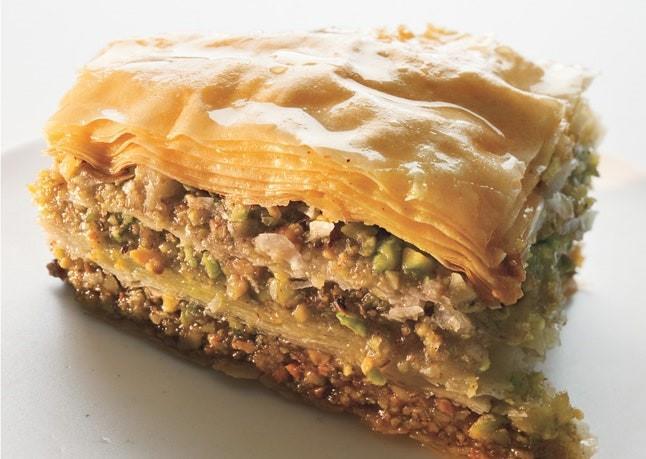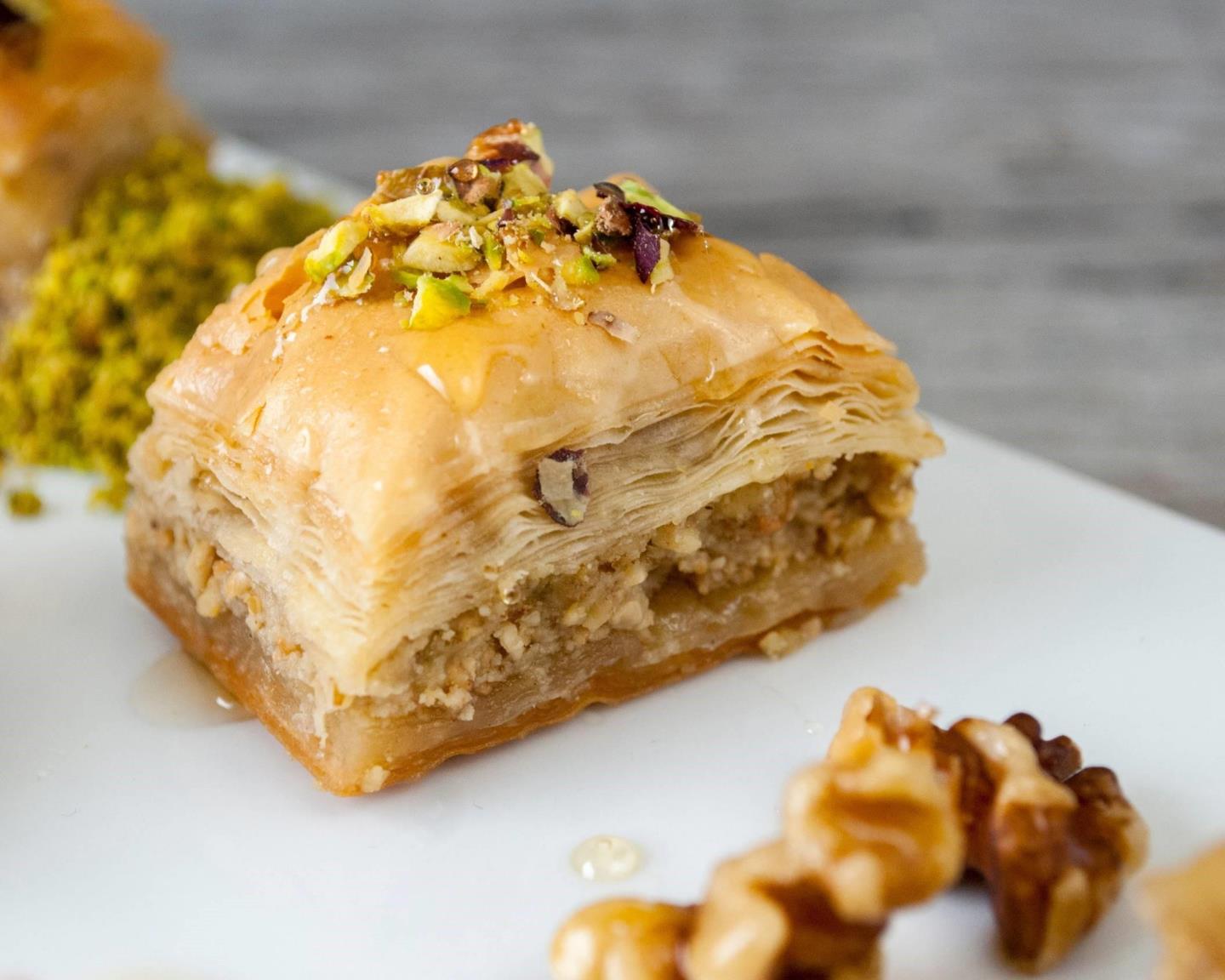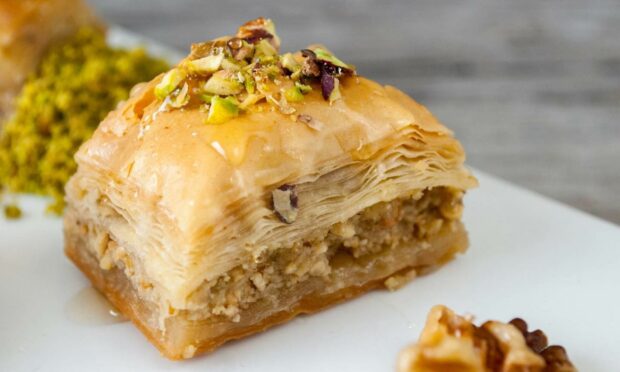Baklava is a delicious dessert which is made of filo pastry and is usually filled with chopped nuts and made incredibly sweet by adding syrup or honey.
The Mediterranean dish is most often associated with both Turkey and Greece, with each country tweaking the recipe slightly to make it unique.
Recipes vary but they will always include the essentials of filo pastry sheets, a sweet syrup, (typically honey mixed with juices and spices), nuts (most often walnuts and/or pistachios), and butter.
The act of layering unleavened flat bread with chopped nuts and honey can be traced back as far as 2025 BC, during the Assyrian Empire.
It is a rich and sticky treat and while it is not hard to make baklava, it is time consuming. However, it is certainly worth the effort.
Fancy giving the Mediterranean layered pastry dessert a go? We’ve got two traditional family recipes from Nihat Oymat, owner of Antioch Restaurant in Dunfermline, that are sure to fit the bill.
Classic baklava
Makes 24-28 pieces [cooks in 1 hour 5 minutes]

Ingredients
- 200g butter, plus extra for greasing
- 200g pistachios
- 50g walnuts
- 50g pecans
- 3 tbsp honey
- Pinch of salt
- 2 x 270g pack filo pastry
For the syrup:
- 250g golden caster sugar
- 50g honey
- 2 tsp orange blossom water
- ½ tsp ground cinnamon
- ¼ tsp ground cardamom (from 3 pods)
- 200ml water
Method
- Heat the oven to 160C Fan/180C/350F/Gas Mark 4 and grease a 21cm x 21cm square cake tin with butter. Chop the nuts into small pieces using a food processor, taking care not to blitz them to a paste. Put them into a bowl, stir in the honey and a pinch of salt and set aside.
- Melt the butter in a pan over a low heat. Cut the first pack of filo pastry sheets in half (so that they fit the tin). Put one sheet in the tin and brush with the melted butter. Lay another sheet on top and brush with butter again, keep layering like this until the whole pack is used up.
- Spread the honey and nut mixture over the pastry and press it down lightly with the back of a spoon. Open the other pack of filo, cut in half and continue the layering and buttering process. When you reach the last sheet pour any remaining butter over the top to finish. Use a sharp knife to cut deep lines into the pastry to create either squares or diamond shapes then bake in the oven for 20 minutes.
- Reduce the heat to 130C Fan/150C/ 300F/Gas Mark 2 and bake for a further 45 minutes. While the baklava cooks put all the syrup ingredients into a saucepan and add 200ml water. Heat gently until the sugar has dissolved then boil the mixture for 8-10 minutes or until it has reduced to the consistency of runny honey.
- When the baklava comes out of the oven, pour the warm syrup over the top, allowing it to run into the lines you have cut. Leave it to soak in and serve when it’s completely cold.
Rose baklava
Makes 16 pieces [cooks in 45 minutes]

Ingredients
- Greek yogurt, to serve
For the syrup:
- 300g golden caster sugar
- Juice of ½ lemon
- 4 tbsp rosewater (not concentrated, see tip)
- 1 large cinnamon stick
- 400ml water
For the baklava:
- 75ml olive oil
- 500g chopped almonds
- 75g golden caster sugar
- 2 tbsp ground cinnamon
- ½ tsp ground cloves
- 150ml rose water (not concentrated, see tip below recipe)
- 250g-270g pack filo pastry sheets
Method
- Put all the ingredients for the syrup in a heavy-based saucepan, and add 400ml cold water. Stir over a gentle heat to dissolve the sugar, then bring to a steady simmer for 10 minutes or until it becomes slightly syrupy. Leave to cool.
- Heat oven to 160C Fan/180C/350F/Gas Mark 4. Lightly brush the sides and base of a 23 x 33cm shallow ovenproof dish with a little of the oil.
- For the baklava, mix together the almonds, sugar, cinnamon, cloves and rose water.
- Place 1 sheet of filo in the bottom of the dish and brush liberally with oil. (If the filo sheets are very large, cut them all in half before using.) Place another one on top and coat again with oil. Repeat this process of layering and brushing with oil until half of the filo sheets are used up. Now spread on the filling and cover with the remaining filo sheets, layering and oiling as before. Be sure to brush the top sheet with oil too. Score the top to form diamond-shaped slices.
- Bake in the oven for about 30 minutes, increasing the heat for the last 5 minutes to 180C fan/200C/400F/Gas Mark 6 to give the pastry a light golden colour.
- Remove from the oven and immediately pour half the cooled rose syrup over the hot pastry. Leave to rest for at least 30 mins so the syrup can seep through the layers. Serve with big dollops of Greek yogurt and the remaining syrup.
Tip: If you can only find concentrated rose water (in a 60ml bottle), use 2 tsp and dilute it in 250ml water. Use 4 tbsp of this diluted version for the syrup, and 150ml for the baklava.
